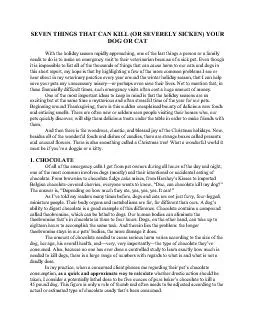PDF-SEVEN THINGS THAT CAN KILL (OR SEVERELY SICKEN) YOUR
Author : trish-goza | Published Date : 2015-10-22
DOG OR CAT With the holiday season rapidly approaching one of the last things a person or a family needs to do is to make an emergency visit to their veterinarian
Presentation Embed Code
Download Presentation
Download Presentation The PPT/PDF document "SEVEN THINGS THAT CAN KILL (OR SEVERELY ..." is the property of its rightful owner. Permission is granted to download and print the materials on this website for personal, non-commercial use only, and to display it on your personal computer provided you do not modify the materials and that you retain all copyright notices contained in the materials. By downloading content from our website, you accept the terms of this agreement.
SEVEN THINGS THAT CAN KILL (OR SEVERELY SICKEN) YOUR: Transcript
Download Rules Of Document
"SEVEN THINGS THAT CAN KILL (OR SEVERELY SICKEN) YOUR"The content belongs to its owner. You may download and print it for personal use, without modification, and keep all copyright notices. By downloading, you agree to these terms.
Related Documents














